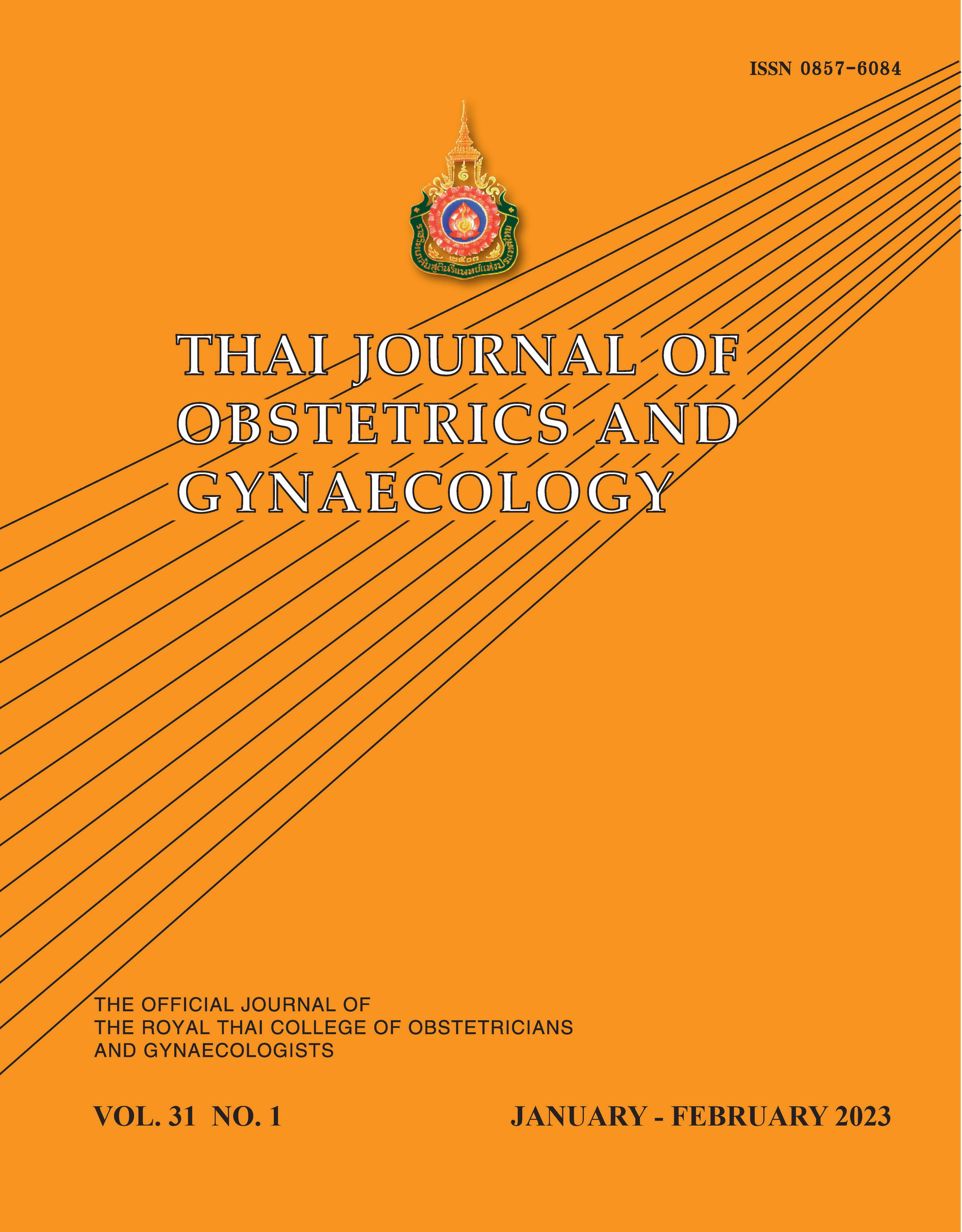Cesarean Section Rate and Associated Risk Factors in Group 1 Robson Classification
Main Article Content
Abstract
Objectives: To evaluate cesarean section (CS) rate among women in group 1 Robson classification, pregnancy outcomes and associated factors.
Materials and Methods: A total of 800 women classified in group 1 Robson classification were included. Data were extracted from medical records including maternal demographic data, obstetric characteristics, labor characteristics and management (cervical dilatation on admission, types of membranes rupture, cervical dilatation at artificial membranes rupture, labor augmentation, and use of analgesia), route of delivery, indications for CS, and pregnancy outcomes.
Results: Overall CS rate was 24.7%. Majority had cervical dilation at admission of < 5 cm (86%). Amniotomy was performed in 66.4% and, of which, 36.3% were performed when cervical dilatation of < 5 cm. Cephalopelvic disproportion (CPD) was the most common indication (74.7 %) followed by and non-reassuring fetal heart rate status (21.2%). Univariate analysis showed that maternal overweight and obesity, cervical dilatation of < 5 cm at admission, spontaneous rupture of the membranes, amniotomy at cervical dilatation of < 5 cm, gestational diabetes mellitus, and preeclampsia were significantly associated with CS. Logistic regression analysis revealed that significant independent factors for CS included overweight or obesity (adjusted odds ratio (OR) 1.58, 95% confidence interval (CI) 1.04-2.10, p = 0.033), amniotomy at cervical dilatation of < 5 cm and spontaneous rupture of membranes (adjusted OR 2.62, 95%CI 1.65-4.17, p < 0.001 and adjusted OR 2.87, 95%CI 1.82-4.53, p < 0.001 respectively).
Conclusion: CS rate among women in group 1 Robson classification was 24.7%. Maternal overweight and obesity, spontaneous rupture of membranes, amniotomy at cervical dilatation of < 5 cm, and preeclampsia were independent associated factors for CS.
Article Details

This work is licensed under a Creative Commons Attribution-NonCommercial-NoDerivatives 4.0 International License.
References
World Health Organization. WHO statement on caesarean section rates. Geneva: World Health Organization 2015 (WHO/RHR/15.02).
Souza JP, Gulmezoglu A, Lumbiganon P, Laopaiboon M, Carroli G, Fawole B, et al. Caesarean section without medical indications is associated with an increased risk of adverse short-term maternal outcomes: the 2004-2008 WHO Global Survey on Maternal and Perinatal Health. BMC Med 2010;8:71.
Sandall J, Tribe RM, Avery L, Mola G, Visser GH, Homer CS, et al. Short-term and long-term effects of caesarean section on the health of women and children. Lancet 2018;392:1349-57.
Lumbiganon P, Laopaiboon M, Gulmezoglu AM, Souza JP, Taneepanichskul S, Ruyan P, et al. Method of delivery and pregnancy outcomes in Asia: the WHO global survey on maternal and perinatal health 2007-08. Lancet 2010;375:490-9.
Betran AP, Torloni MR, Zhang JJ, Gulmezoglu AM, WHO Working Group on Caesarean Section. WHO statement on caesarean section rates. BJOG 2016;123:667-70.
Betran AP, Ye J, Moller AB, Zhang J, Gulmezoglu AM, Torloni MR. The Increasing trend in caesarean section rates: global, regional and national estimates: 1990-2014. PLoS One 2016;11:e0148343.
Boerma T, Ronsmans C, Melesse DY, Barros AJD, Barros FC, Juan L, et al. Global epidemiology of use of and disparities in caesarean sections. Lancet 2018;392: 1341-8.
Vogel JP, Betran AP, Vindevoghel N, Souza JP, Torloni MR, Zhang J, et al. Use of the Robson classification to assess caesarean section trends in 21 countries: a secondary analysis of two WHO multicountry surveys. Lancet Glob Health 2015;3:e260-70.
Torloni MR, Betran AP, Souza JP, Widmer M, Allen T, Gulmezoglu M, et al. Classifications for cesarean section: a systematic review. PLoS One 2011;6:e14566.
Betran AP, Vindevoghel N, Souza JP, Gulmezoglu AM, Torloni MR. A systematic review of the Robson classification for caesarean section: what works, doesn’t work and how to improve it. PLoS One 2014;9:e97769.
Anekpornwattana S, Yangnoi J, Jareemit N, Boriboonhirunsarn D. Cesarean section rate in Siriraj Hospital according to the Robson classification. Thai J Obstet Gynaecol 2020;28:6-15.
American College of Obstetricians and Gynecologists, Society for Maternal-Fetal Medicine, Caughey AB, Cahill AG, Guise JM, Rouse DJ. Safe prevention of the primary cesarean delivery. Am J Obstet Gynecol 2014;210: 179-93.
World Health Organization. WHO recommendations: intrapartum care for a positive childbirth experience. Geneva: World Health Organization 2018.
Jackson S, Gregory KD. Management of the first stage of labor: potential strategies to lower the cesarean delivery rate. Clin Obstet Gynecol 2015;58:217-26.
Barber EL, Lundsberg LS, Belanger K, Pettker CM, Funai EF, Illuzzi JL. Indications contributing to the increasing cesarean delivery rate. Obstet Gynecol 2011;118: 29-38.
Alhafez L, Berghella V. Evidence-based labor management: first stage of labor (part 3). Am J Obstet Gynecol MFM 2020;2:100185.
Smyth RM, Markham C, Dowswell T. Amniotomy for shortening spontaneous labour. Cochrane Database Syst Rev 2013;6:CD006167.
Harrison MS, Betran AP, Vogel JP, Goldenberg RL, Gulmezoglu AM. Mode of delivery among nulliparous women with single, cephalic, term pregnancies: The WHO global survey on maternal and perinatal health, 2004-2008. Int J Gynaecol Obstet 2019;147:165-72.
D’Souza R, Horyn I, Pavalagantharajah S, Zaffar N, Jacob CE. Maternal body mass index and pregnancy outcomes: a systematic review and metaanalysis. Am J Obstet Gynecol MFM 2019;1:100041.
International Weight Management in Pregnancy (i-WIP) Collaborative Group. Effect of diet and physical activity based interventions in pregnancy on gestational weight gain and pregnancy outcomes: meta-analysis of individual participant data from randomised trials. BMJ 2017;358:j3991.
Gestational hypertension and preeclampsia: ACOG Practice Bulletin, Number 222. Obstet Gynecol 2020;135:e237-e60.
World Health Organization. WHO recommendations non-clinical interventions to reduce unnecessary caesarean sections. Geneva: World Health Organization 2019.


